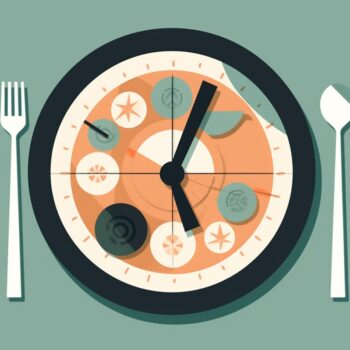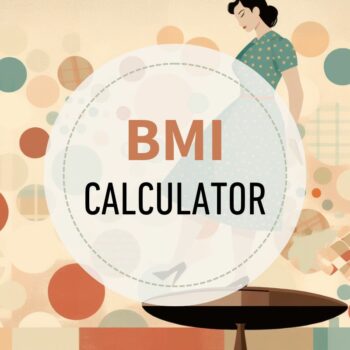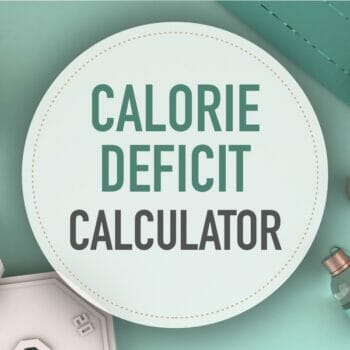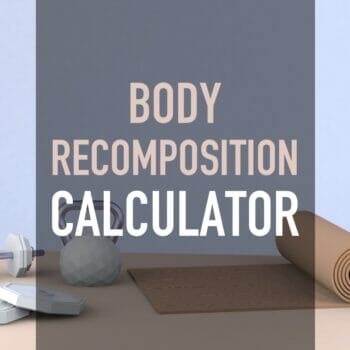Macro Calculator
This free, easy-to-use macro calculator gives you your optimal macronutrients and calories. It’s a weight loss or muscle gain calculator for both women and men.
Combine with macro counting or flexible dieting to reach your goals faster.
How to get leaner and stronger?
Our comprehensive macro-based fat loss program shows you how. Learn more
How do macros work?
The foods we eat are made up of three macros (macronutrients). These are carbohydrates (carbs), protein, and fat.
Chicken is high in protein but has no carbs; rice is high in carbs but has very little fat or protein. The three macronutrients provide the body with energy and raw materials for growth and repair.
By calculating the appropriate daily calorie amount for you, we can then break this down into the best macronutrient ratios to achieve weight loss.
Basic steps for macro counting
- Enter details into the calculator
Make sure to choose the correct goal. - Take note of your calories and macros
These will be the targets you are aiming for each day. - Track your macros
Use an app or pre-plan your meals. - Measure results
Don’t use basic weight scales.
Use proper body composition scales (we recommend Renpho) to measure fat and muscle mass changes.
What is a good macro ratio for fat loss or muscle gain?
Your macros should be based on your Total Daily Energy Expenditure (TDEE) and goals.
The calculator defaults to the best macro ratio proven to work for most people.
This ratio is:
- 30% fat
- Protein is 0.65 grams per pound of body weight,
- The remainder is carbs.
Depending on your goal, this will be either a calorie deficit or a surplus.
You can go further and make more adjustments: Perhaps you’re an extreme endomorph and do better with fewer carbs. Or perhaps you have one kidney and need to eat less protein.
You can fine-tune your results with a bit of math. See how to change your macros here.
What is a good protein ratio?
Rather than a percentage, proteins are based on your body weight. Our calculator has three settings:
- Moderate adjusts the ratio to 0.65 grams per pound of body weight.
This is appropriate for sedentary individuals or people with higher body fat percentages. - High is for active people with moderate strength training and an average body fat percentage.
- Maximum will set the ratio to 1 gram per pound.
This amount is good for bodybuilding and gaining muscle mass. You must be doing intense training.
Find out how to fine-tune your protein ratios when counting macros
Fat macro ratio
Set fat at 30% of daily energy expenditure.
Most people do very well with this amount of fat. See more about choosing the best macro fats. Because of high-fat diets like keto, many people are now eating more fat than they need to.
Carbohydrate macro ratio
Once you’ve calculated protein and fat, the remainder of your daily calories should be from carbohydrates.
Carbs fuel your body and workouts – and are the body’s preferred energy source.
If you are coming from a low-carb background, this may seem high. However, according to respected nutritional research, this is a moderate amount of carbs.
If you are eating according to your TDEE, the notion that carbs cause weight gain or stop fat loss is incorrect.
Using as a Calorie Deficit Calculator
As a weight loss calculator, this tool establishes a safe calorie deficit only.
The Lose option puts you in a 20% calorie deficit, promoting safe, steady weight loss.
The best macro ratio for body recomposition
If you want to recompose your body (lose fat and gain muscle simultaneously), then use the body recomposition calculator.
Macro ratio for maintenance
The Maintain button shows you the macro levels to maintain your current weight.
This is great if you have lost weight and don’t want to gain it back.
Macro ratio for muscle gain
The Gain button puts you in a 20% calorie surplus.
The macro breakdown is designed to build muscle fast in conjunction and must be combined with a comprehensive weight training program.
Underweight people can also use it.
TIP: Try starting with the maintenance goal and gradually increasing calories if you want lean muscle gains.
Calculating macros using your body fat percentage
The calculator uses your body weight to determine calories and macros.
However, you can obtain superior results by using your body fat percentage. The calculator allows you to choose which method: Normal for body weight, Lean Mass for fat percentage.
When to choose the Lean Mass Formula
If you are lean (have a low body fat percentage), choose the Lean Mass formula and enter your body fat %.
If you are classified as obese and have a lot of weight to lose, the lean mass formula is superior. You can read more about macro counting and obesity.
Help? Calculate your ideal body weight or get an assessment of your body fat percentage.
Why the difference? Muscle cells burn more calories than fat cells, so the more accurately we measure this, the better your results will be.
How to calculate macros per meal
You can break this down into meals once you’ve calculated your daily macros in the calculator.
Choose from 2 to 6 meals daily to see the macro ratio you can track for each meal. For some people, this is easier, but for others, this is too much detail.
Do what works for you.
Meal Plans
See a 5-day macro-based meal plan. It includes three meals and two snacks per day.
Macro calculator activity level settings
A higher activity level means a higher daily calorie goal.
For example – if you maintain your weight at 2,000 calories per day, adding vigorous daily exercise means you need more calories to maintain your weight.
If you are sedentary and trying to lose weight, adding exercise will increase your daily calorie goal.
The idea seems counter-intuitive, but more energy is required to fuel your workouts. More workouts lead to increasing metabolism; therefore, more fat is burned!
Undereating is one of the leading causes of the weight loss plateau.
So many of our clients previously “hit the wall” with dieting. They would continually reduce calories, stop losing fat, and gain weight when they eat a little more.
Macro counting defeats this by prescribing the right food and calorie levels.
Which activity level do I choose?
- Sedentary: Just regular everyday activity like a bit of walking, a couple of flights of stairs, eating, etc.
- Light: Any activity that burns 200-400 calories (females) or 250-500 calories (males) over your sedentary amount.
- Moderate: Any activity that burns 400-650 calories (females) or 500-800 calories (males) more than your sedentary amount.
- Extreme: Any activity that burns more than 650 calories (females) or more than 800 calories (males) in addition to your sedentary amount.
Other options for determining your calorie burn
- Use our calories burned calculator – it accurately assesses over 380 activities.
- Use a fitness tracker – like a Fitbit or Apple Watch (note that they can overestimate calorie burn).
- Use a suitable app – like MapMyFitness
Why should I eat more when I exercise more?
High physical activity not fueled with enough calories will lead to muscle catabolism (breakdown of muscle fiber).
This lack of nutrition could stall your weight loss, so eat up if you love to exercise!
I’ve got my macros – now what?
Once you’ve identified your target daily macros, you must determine the macros in all your foods.
By tracking them daily, you can reach your recommended macro targets that encourage fat loss, muscle gain, or whatever your goal may be.
You can learn more about the macro counting system and the flexible dieting philosophy. Many people use an app like Myfitnesspal to track macros.
For more specifics on what to eat – see a sample macro meal plan or a list of macros for familiar foods.
View article sourcesSources
- Mifflin, M. D., St Jeor, S. T., Hill, L. A., Scott, B. J., Daugherty, S. A., & Koh, Y. O. (1990). A new predictive equation for resting energy expenditure in healthy individuals. The American Journal of Clinical Nutrition, 51 (2), 241-247. Link
- McArdle, W. D., Katch, F. I., & Katch, V. L. (2010). Exercise physiology: nutrition, energy, and human performance. Lippincott Williams & Wilkins. Link
- Jequier, E. (1994). Carbohydrates as a source of energy. The American journal of clinical nutrition, 59(3), 682S-685S.
- Lemon, P. W., Tarnopolsky, M. A., MacDougall, J. D., & Atkinson, S. A. (1992). Protein requirements and muscle mass/strength changes during intensive training in novice bodybuilders. Journal of Applied Physiology, 73(2), 767-775. study abstract link
- Grundy, S. M. (1999). The optimal ratio of fat-to-carbohydrate in the diet. Annual review of nutrition, 19(1), 325-341. abstract
- Conlin, L.A., Aguilar, D.T., Rogers, G.E. et al. Flexible vs. rigid dieting in resistance-trained individuals seeking to optimize their physiques: A randomized controlled trial. J Int Soc Sports Nutr 18, 52 (2021). https://doi.org/10.1186/s12970-021-00452-2
2,104 Comments


 Menopause Macro Calculator
Menopause Macro Calculator Intermittent Fasting Calculator
Intermittent Fasting Calculator BMI Calculator
BMI Calculator Calorie Deficit Calculator
Calorie Deficit Calculator Body Recomposition Calculator
Body Recomposition Calculator
Hi! I’m 66 in good shape. I’m 5 ft 3 so Wright us alright. I’m wanting to lose fat I’ve gained in my stomach, breasts, arms and thighs. Will this be a good fit for this?
Hey Cris, Most definitely. I’ve worked with 100s your age and they’ve been successful. My menopause calculator might be of better use for you though. Menopause Macro Calculator
Hi, I weigh 135, 25yrs old & 24.83 body fat% currently, I’m trying to get to 20% body fat %, WHILE maintaining & building my muscles, is this possible? If so are the macros I gathered above accurate? High carbs (225 daily, 111 protein, & 64 fat? Because in order to BUILD muscle or gain healthy weight in general, I thought we have to eat 1gram per body weight, which ideally would be 145 G protein if I wanted to weigh 145 but with lower fat %, more toned.
Hi Daija, Thanks for stopping by. I can’t see all the things you entered so not sure if your numbers would be correct, but with the right macros, you can get leaner whilst building muscle. The 1 gram per pound notion isn’t really accurate because protein needs depend on how much lean mass you have not total body weight. I’m more than happy to help dial in those calculations for you here. Expert Macro Calculations
Trying
I am 5’6” and 46 years old. I weigh 143. I just had my body composition analysis done and my dry lean mass is 24.5 pounds, my water is 67.2, my body fat mass is 51.5. What should my macros be and caloric intake? I would like to be 134 and muscular. I currently workout 3-4 days a week, light cardio and weight lifting.
Hi Tanya, If you want me to personally calculate things for you, I do offer that as part of my Macro Solution program here: The Macro Solution
Due to my weight I need to 248 grams of protein a day. Any suggestions on how to add more fiber and still meet the calorie goal of 2233? I notice my bowels have slowed down. Thanks.
Hi Rena, Just note that if you have more than 50 pounds of fat tissue this will skew your calorie and protein recommendations. Therefore, your protein should be based on your lean mass and not total weight. I’d be happy to get everything dialed in for you since calculators can’t always give people the optimal results due to lots of individual differences.
Hi, I’m a 32 year old male. I’m 5’7 160 lbs, and trying to get into weightlifting but I’m fairly confused on how many calories I should consume, and how to ratio my macros. I’d say I’m in the “lightly active” range since I’ve begun lifting. I have a little bit of a belly, so I’m a bit torn cause I’m afraid to add onto the belly fat, but hear that just comes with lifting, and that you need to be at a calorie surplus to build muscle, and that you can just lose the belly fat later on. That being said, what calories/macro ratio should I use? I heard protein should be the highest category, then carbs then fat, is that correct? Thanks!
Hey Ben, You can gain muscle and get leaner at the same time with the right calorie and macro balance. Customize the deficit to 10% and set the protein to max. Evaluate every two weeks and make small changes if needed based on your results. If you need more guidance consider coaching with me or my Macro Solution program.
Hi I’m a 33 year old female, 5′ 6, 210 pounds and I’m 6 weeks pregnant. I’m wondering how to calculate my macros for each trimester.
Hi Melissa, Congratulations! I’ve written a guide about that here: TDEE and Macro Calculations for Pregnant or Breastfeeding Women
Hi, I’m 30 years old, 5’11” and weigh about 185LBs with somewhere between 11-15% body fat (based on what my scale says, not sure how accurate that is) I want to loose fat and gain some muscle. I work out about 3-4 days a week burning about 500 active calories per session and go on a 25 min walk every day burning about 150 active calories. I currently have my macros at 2,669 calories per day with 43% carbs(289g), 27% protein(178g) and 30% fat(89g). I do feel that I have been making progress since making this macro change base on your calculator. Just wondering if you thought this is on track for my goals.
Hi Lorenzo, It does seem pretty good especially since you are making progress. The key is assessing every two weeks and then making small changes if needed by adding or subtracting around 100-150 calories depending on what your progress data is showing you.
Hi, I am trying to regain my body after pregnancy. I am breastfeeding, how many extra calories should I be eating but still lose weight? Also what activity level is looking after a 3 year old and a 5month old baby? 🤪
Hi Stephanie, After establishing a deficit you’ll want to add in 400 calories for best feeding. The activity level could depend but start with “light activity”. All the best!
Awesome
Is it possible to lower body fat and gain muscle mass at the same time or am I better off focusing on lowering body fat then muscle gain later?
Hi Tammy, If you have more than 10 pounds to lose focus primarily on fat loss, but your deficit shouldn’t extreme. You don’t want to lose muscle during the process which is why the calculator recommends a max 20% deficit.
Uh hi, I don’t know what I’m doing anymore. I’m 5’11, 217lbs, 24.1% body fat (using online calculator and body tape measure), I’ve been told I need to eat at least 2800 to maintain, so with a decent deficit I chose 2200 calories but it’s a struggle to eat. Also been told I need about 275g carbs, 175-200g protein and 60-80g fat daily. I lift 6 days a week and cardio after 4 days a week, I haven’t noticed weight loss. Typically in a week and a half I can lose at least 2 pounds but my body stays the same. I’m not sure if I’m retaining water or not eating enough and or my macros are wrong. I try not to eat a lot of sodium either, just tired of not shedding body fat and feeling weak at the gym cause I’m afraid to eat.
Hi Joshua, There could be a number of factors at play and calculators don’t always give you the most accurate calculations due to those factors. There is a solution, rest assured. Would you consider some nutritional coaching?